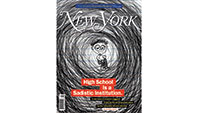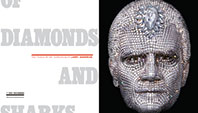
1. “Ever wonder why the high-school years are the focus of so many movies, books, and fun memories you can’t get over despite years of therapy?” asked Lauren O’Neal at the Rumpus, recommending Jennifer Senior’s study of how the “sadistic institution” warps the lives of those who pass through it (“Why You Truly Never Leave High School,” January 28). The article clearly struck a chord, generating an unusually large and heartfelt response. “High school is where we make our template. And even if we break out of that template later in life, it still circumscribes our expectations and our limitations (poking some significant holes in the fantasy of rugged individualism—it’s tough to pull yourself up by your bootstraps when you don’t even have boots),” wrote Lindy West at Jezebel. “Anyway, the gist, for all people in high school and beyond: The stuff in your head seems way more real than it actually is. No one is paying attention to you, so stop freaking out. Stop hating yourself. Find something you like and do that thing, and other people who like you will find you.” At the New York Times’ Motherlode blog, KJ Dell’Antonia also tried to sketch an escape route. “Reading her article is likely to catapult you back into your own adolescent trauma (universal reaction in the comments is best summed up as either ‘totally!’ or ‘that is so not me’), but I propose we seek a more constructive take-away: we may still be nerds, pretty girls or jock stars, but our own children may not yet be living in those narrow boxes. If we can give our teenagers the opportunity to follow their passions toward larger groups of people who share them, they’ll also get a shot at internalizing a broader view of who they are. In a high school of 1,000 people, you may be a debate nerd. At a similarly sized debate camp, other labels await.” But at least one commenter was able to get past the neurology and social science: “My favorite part of this article is the news that there is a Heathers musical in development.”

2. “Larry Gagosian’s power might be waning (maybe), but the mystery surrounding the infamously press-shy art dealer is as appealing as ever—particularly as he fights numerous legal battles and faces almost a full stable of defecting artists,” wrote Shane Ferro at ArtInfo of Eric Konigsberg’s portrait of the man long considered the world’s most powerful gallerist (“Of Diamonds and Sharks,” January 28). At Art History News, Bendor Grosvenor circled the juiciest bits: “Of chief interest is the conversation between ‘collector’ Alberto Mugrabi, Sotheby’s, and Gagosian, about a forthcoming auction of a work by Warhol, Hammer & Sickle, which was in danger of failing to sell, something Mugrabi and Gagosian, as holders of numerous Warhols, were keen to avoid. It highlights the inappropriate way in which many in the art world take commissions from both ends of a deal—and how, in an auction setting, it can give rise to substantial conflicts of interest.” But possibly the most interesting response came from gallerist Edward Winkleman, who focused not on the story’s gossipy elements but on the cross-section case study of the art business it offered—and especially on big-deal collector Ronald Perelman’s suggestion that art was an investment like any other and should be expected to appreciate. “That points back to how the middle of the market is being left behind in all this. We, humble art dealers in the middle of the market, are clearly not even in the same industry as those we like to think we’ll catch up to someday. How cute it must seem to collectors in that stratosphere when a middle-tiered dealer who finally gains an audience insists on discussing the aesthetic values of a work, when it’s clear they can’t tell a FAB Spread from a Buying Hedge,” he wrote. “Gallerists who were once the fiercest of champions for all their artists begin to take measures to protect themselves instead, once their top artists decide to move to a top-tier gallery. The nurturing environment that the middle of the market once represented suffers as a consequence. And that’s self-perpetuating. If a rising artist in a middle-tier gallery senses a new distance from their dealers (who’s responding to having had their top artist poached), that rising artist feels less motivation to remain loyal as well.”
Correction: The restaurant Mission Chinese has always taken a (very) limited number of reservations via e-mail. Last week, “The Approval Matrix” suggested that this was a new policy.
Send correspondence to: nymletters@nymag.com